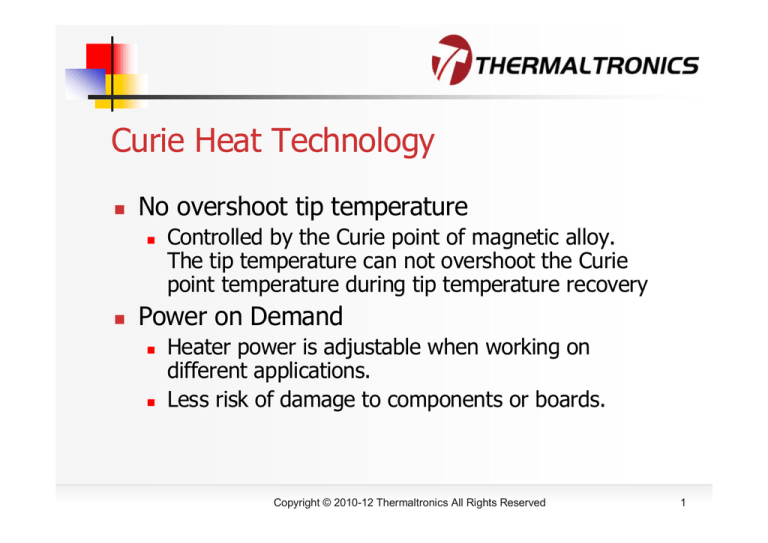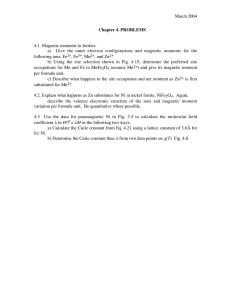
Curie Heat Technology
n
No overshoot tip temperature
n
n
Controlled by the Curie point of magnetic alloy.
The tip temperature can not overshoot the Curie
point temperature during tip temperature recovery
Power on Demand
n
n
Heater power is adjustable when working on
different applications.
Less risk of damage to components or boards.
Copyright © 2010-12 Thermaltronics All Rights Reserved
1
Conventional Heating Technology
n
Variable temperature
n
n
n
The tip’s set temperature is not the maximum tip
temperature that can be reached
The tip temperature can overshoot the maximum
temperature during tip temperature recovery
Constant Power
n
n
Heater power is not adjustable when working with
different joints
This can easily damage the components and
requires operator training
Copyright © 2010-12 Thermaltronics All Rights Reserved
2
Curie Heat Technology
Thermaltronics tip cartridge heater’s consist of coil assembly (1), special formulated magnetic
alloy (2) and copper core (3).
Magnetic Layer (2)
Copper Core (3)
Coil Assembly (1)
Copyright © 2010-12 Thermaltronics All Rights Reserved
3
Curie Heat Technology (Con’t.)
Initially a high frequency current is passed over the heater through the coil assembly (1). Due to
the skin effect, the inductive current flow is confined to the “skin” or magnetic layer (2) of the
heater. This causes the heater to heat up rapidly.
Magnetic Layer Heating Up (2)
Copper Core (3)
Inductive Current Flows over Skin depth
of heater (1)
Copyright © 2010-12 Thermaltronics All Rights Reserved
4
Curie Heat Technology (Con’t.)
As the magnetic alloy temperature reaches it’s curie point temperature, it loses its magnetic
properties which eliminates the skin effect (2). This causes the transfer of inductive current to the
copper core of the heater (3).
Magnetic Layer Reaches Curie Temp. (2)
Copper Core
Heating Up (3)
Inductive Current Flows through
copper core (1)
Copyright © 2010-12 Thermaltronics All Rights Reserved
5
Curie Heat Technology (Con’t.)
If the tip cools slightly (soldering a joint) the magnetic alloy heater drops below it’s curie point
temperature and it’s magnetic properties reappear. This causes the skin effect reappear, the
inductive current once again travels across the skin of the heater and causes the heater to heat
rapidly (2).
Magnetic Layer Heating Up Again (2)
Copper Core (3)
Inductive Current Flows over Skin
depth of heater (1)
Copyright © 2010-12 Thermaltronics All Rights Reserved
6
Curie Heat Technology – Heat Generation
Lots of Heat Generated
Heat / Power
T = Tip Temperature
Tc = Heater’s Curie Point Temperature
Not Much Heat Generated
Magnetic
Tc
Ferromagnetic
Temperature
Curie Temperature
Copyright © 2010-12 Thermaltronics All Rights Reserved
7
Curie Heat Technology (Con’t.)
Heat / Power
Conventional Iron
Curie Heat
Temperature
Copyright © 2010-12 Thermaltronics All Rights Reserved
8
Definition of Curie Point
The point where at a given temperature a magnetic alloy loses it’s magnetic property. Each
magnetic alloy has a different curie point.
A nickel paper clip attached to a base with a string is suspended in air by the use of a magnet.
If the nickel paper clip is heated with a lighter beyond a certain temperature called the “Curie
Point” it is no longer attracted by the magnet and will fall into the water.
Copyright © 2010-12 Thermaltronics All Rights Reserved
9
Definition of Induction Heating
Induction heating is based on the principle that magnetic materials will self heat when placed into
an inductive field.
Copyright © 2010-12 Thermaltronics All Rights Reserved
10
In physics and materials science, the Curie temperature (Tc),
or Curie point, is the temperature at which a ferromagnetic or
a ferrimagnetic material becomes paramagnetic on heating; the
effect is reversible.
μ = Magnetic permeability
B = Magnet Flux Density
H = Magnet Field
Copyright © 2010-12 Thermaltronics All Rights Reserved
11
n
n
Every Atom has “N”orth and “S”outh Polarity
Magnetic Momentum = M
Copyright © 2010-12 Thermaltronics All Rights Reserved
12
n
When atoms are in disorder
M = 0 (Magnetic Moment)
Paramagnetic
M=0
n
When atoms are in order
M > 0 (Magnetic Moment)
Ferroamagnetic
M>0
Copyright © 2010-12 Thermaltronics All Rights Reserved
13
Definition of Skin Effect
Skin effect is a tendency for alternating current (AC) to flow mostly near the outer surface of a
solid electrical conductor, such as metal wire,
• When current flows through a wire, the resistance is “R”
• The higher frequency of the current the more skin effect occurs as the “magnetic shielding”
• As the resistance becomes bigger, more heat generated.
Current travels along outer surface
Copyright © 2010-12 Thermaltronics All Rights Reserved
14
Skin Depth when Skin Effect Occurs
n
n
The higher the frequency the thinner the skin depth
The higher the resistance, the more heat is generated
Skin Depth
Copyright © 2010-12 Thermaltronics All Rights Reserved
15


